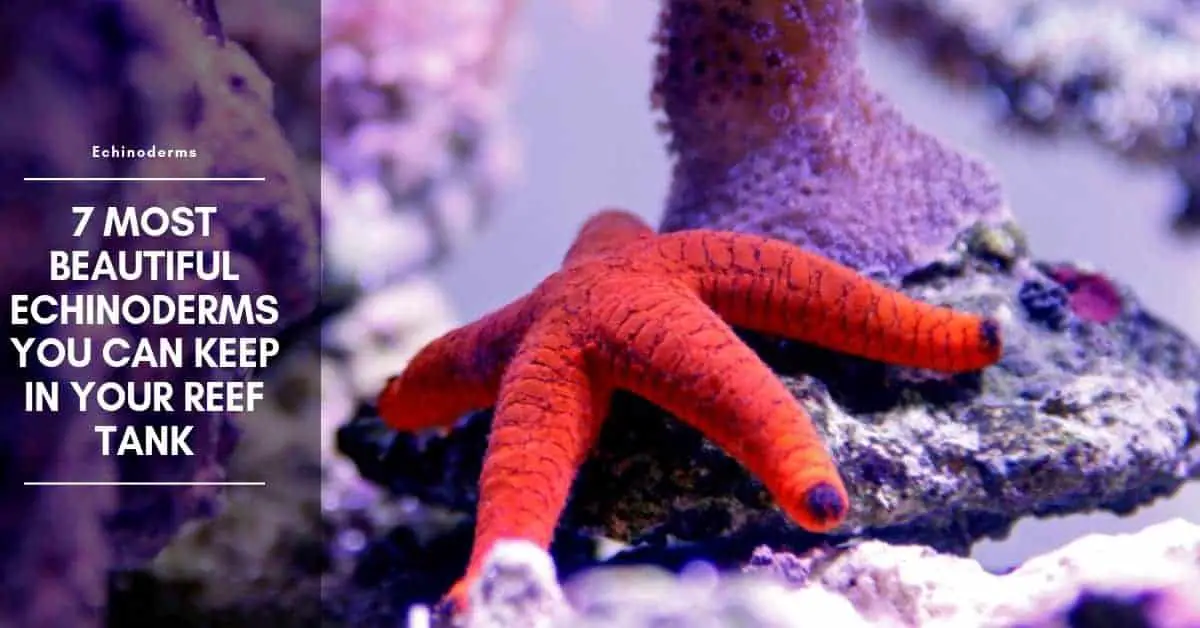Starfish are the best-known echinoderms, but the group also features feather and brittle stars, as well as sea urchins and sea cucumbers.While they vary in shape, all these creatures have an internal body structure formed from calcium, and tube feet that enable them to move over the seabed. Some echinoderms, including many starfish, are easy to maintain in aquariums, but sea cucumbers have a devastating habit of eviscerating themselves when they become distressed, fatally polluting the water for the other tank occupants.
Little Red Starfish
- ORIGINS – Occurs throughout the Indo-Pacific region, especially off Indonesia.
- SIZE – 3 1 ⁄4 in (8 cm).
- DIET – Mussel, clam, and shrimp meat. Beware of overfeeding these and other echinoderms.
- WATER – Temperature 77–79°F (25–26°C); alkaline (pH 8.1–8.3) with SG 1.020–1.024.
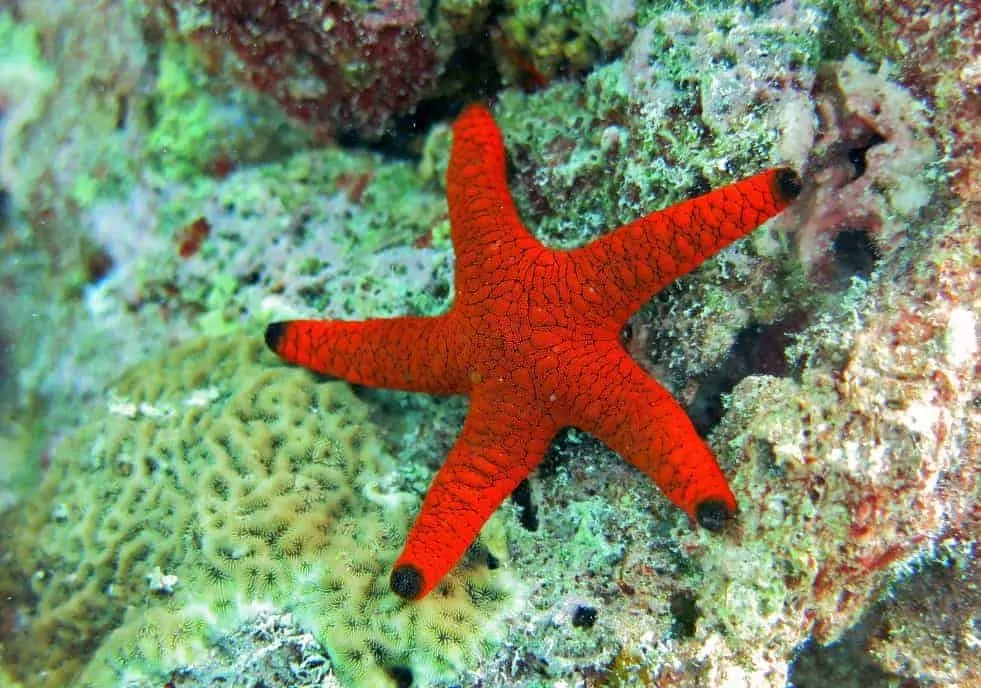
With their bright red coloration, Red Starfish make small, attractive additions to a reef tank. Juvenile Red Starfish can be recognized by the black tips of their arms (as shown above). Unlike some of their relatives, these starfish can be kept safely with other invertebrates. However, avoid housing Red Starfish with larger predatory starfish species, which will eat them. Some crustaceans may also prey on them.
Red-Knobbed Starfish
- ORIGINS – Ranges from the Red Sea to Indonesia and islands of the Pacific.
- SIZE – 12 in (30 cm).
- DIET – Mussel, clam, and shrimp meat. Place a small amount of food under the starfish each day.
- WATER – Temperature 77–79°F (25–26°C); alkaline (pH 8.1–8.3) with SG 1.020–1.024.
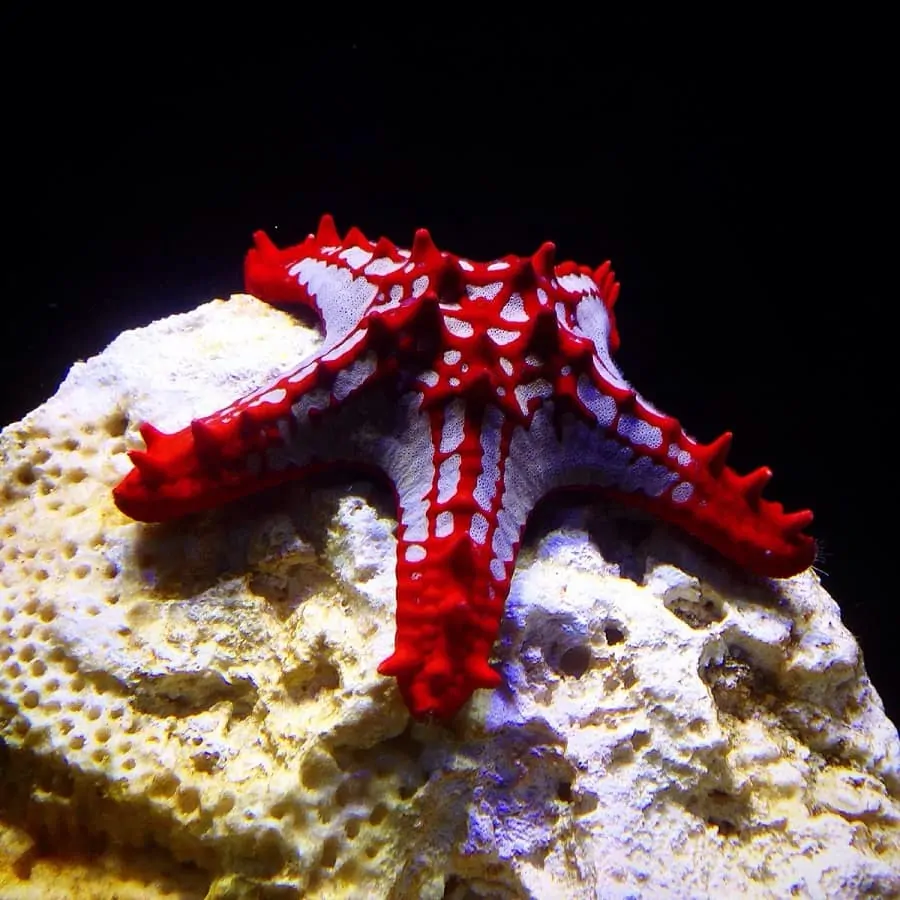
Swollen red areas on the body and arms help to identify these predatory starfish; the red areas form a meshlike pattern against a whitish background. Red-Knobbed Starfish are relatively easy to keep, but they will attack and feed on sessile invertebrates sharing their quarters, as well as any mollusks that they can ambush, so their companions need to be chosen very carefully.
API STRESS COAT Aquarium Water Conditioner 16-Ounce Bottle
29% OffAPI STRESS ZYME Freshwater and Saltwater Aquarium Cleaning Solution 16-Ounce Bottle
API ACCU-CLEAR Freshwater Aquarium Water Clarifier 4-Ounce Bottle
13% OffBrittle Starfish
- ORIGINS – Tropical areas, notably off the coast of Florida and throughout the Caribbean region.
- SIZE – 6 in (15 cm).
- DIET – Mussels, shrimp, and other meaty foods. Try to vary the type of food offered.
- WATER – Temperature 77–79°F (25–26°C); alkaline (pH 8.1–8.3) with SG 1.020–1.024.
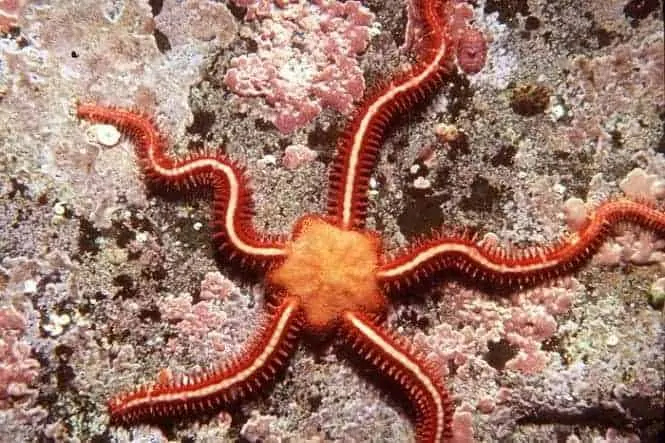
Brittle Starfish have a small central disk and long, thin arms that are fringed along their entire length. They are ideal starfish for a reef tank because they will scavenge for food without harming the other invertebrates that share their quarters. They can locate food by smell and are able to reach into nooks and crannies to seek out food particles that are beyond the reach of other tank occupants.
Feather Starfish
- ORIGINS – Off the coast of Southeast Asia, notably in the vicinity of Singapore and parts of Indonesia.
- SIZE – 7 in (18 cm).
- DIET – Brine shrimp and other small foods. Try to place the food close to the starfish to encourage it to feed.
- WATER – Temperature 77–79°F (25–26°C); alkaline (pH 8.1–8.3) with SG 1.020–1.024.
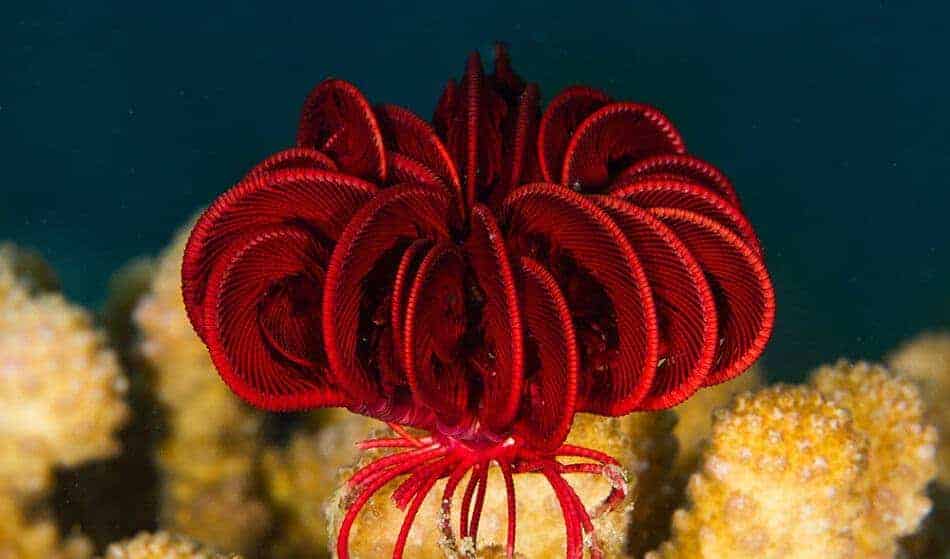
This placid, red starfish usually feeds after dark, waving its highly mobile, feather-like arms in the current to collect fine particles of food. Feather Starfish can be kept in groups, providing retreats for small, non-aggressive fish, such as gobies. As with other starfish species, if an arm breaks off, it will usually regenerate. Good water conditions are vital for the overall well-being of Feather Starfish.
Bun Starfish
- ORIGINS – Widely distributed throughout the entire Indo-Pacific region.
- SIZE – 10 in (25 cm).
- DIET – Mussel, clam, and shrimp meat. Offer small amounts each day, removing any uneaten scraps.
- WATER – Temperature 77–79°F (25–26°C); alkaline (pH 8.1–8.3) with SG 1.020–1.024.
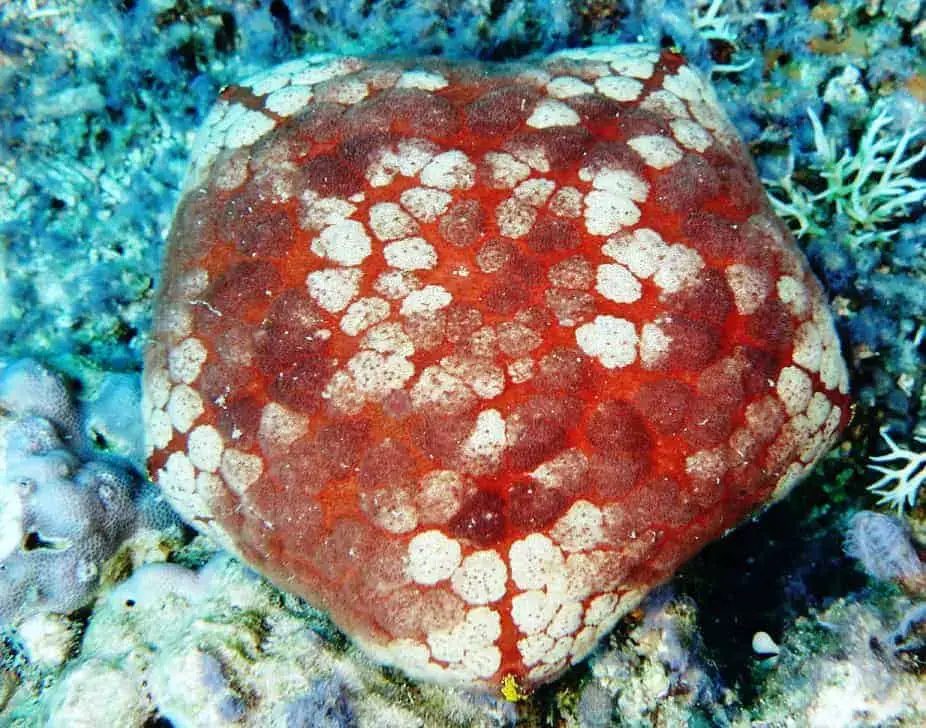
When Bun Starfish are mature, their bodies fill out so much that their five legs are no longer visible. One of the heaviest of all starfish, they have spotted upper-parts, but their markings and coloration are highly variable. These predatory starfish are best housed alongside non-aggressive fish, rather than in a reef set up because they will attack sessile invertebrates, such as corals.
Sea Apple
- ORIGINS – Found on coral reefs of Indonesia, and also on Australia’s Great Barrier Reef.
- SIZE – 6 in (15 cm).
- DIET – Food particles in suspension. Use liquid foods. May also take brine shrimp.
- WATER – Temperature 77–79°F (25–26°C); alkaline (pH 8.1–8.3) with SG 1.020–1.024.
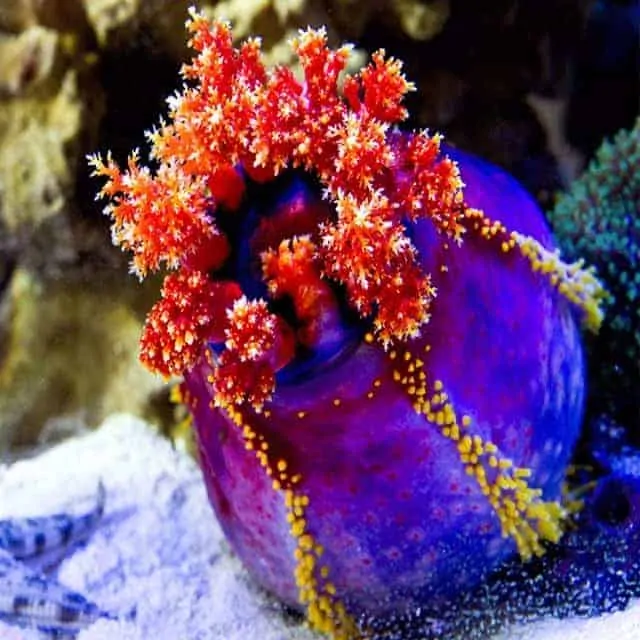
The purplish-blue form of this echinoderm, which occurs on the Great Barrier Reef, is exceptionally beautiful. Sea Apples of Indonesian origin are smaller, with grayish-pink bodies. The tentacles projecting from the body are used to extract fine food particles from the water. Tank-mates for Sea Apples must be chosen carefully because some fish will try to bite off their feeding tentacles.
Sea squirts – Tunicate
These reef animals feed by drawing water in through the large hole in the top of the body, then filtering it for edible particles, and finally passing it out through a smaller orifice called the exhalant siphon.
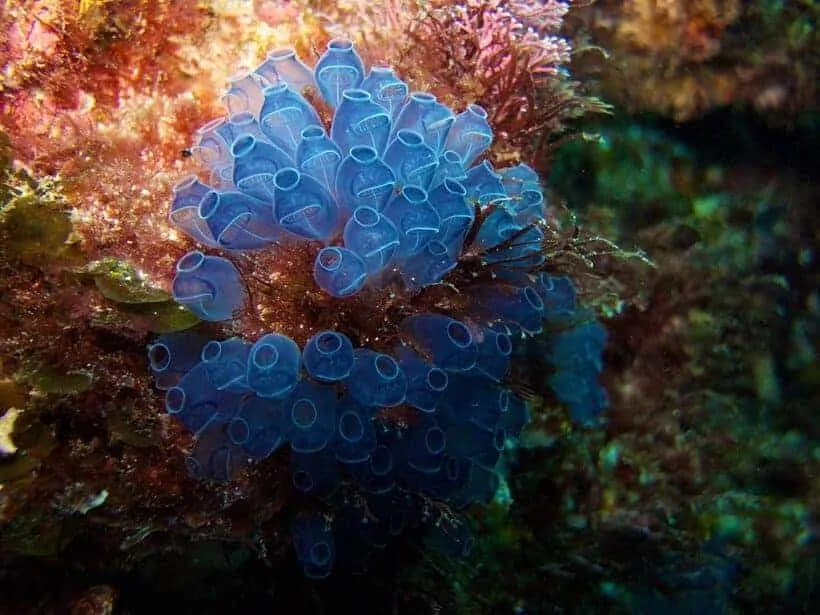
Like the other species featured in this section, sea squirts do not have a backbone, yet these creatures are actually classified in the same phylum as vertebrates. This apparent oddity of classification comes about because when they are free-swimming larvae, sea squirts possess a well-developed nervous system.
This includes stiff central support, called a notochord, which is similar to the spinal cord. Once they have matured, however, sea squirts adopt a wholly sedentary lifestyle and lose these features. Sea squirts can grow to a relatively large size, with some species measuring up to 20 in (50 cm) in length.
Being highly vulnerable to predators, they inhabit inconspicuous areas of the reef, where they often associate in groups. Like Turbo Snails, sea squirts may turn up unexpectedly in a marine aquarium, being introduced accidentally when pieces of live rock are added to the tank.

Hi, my name is Sean, and I’m the primary writer on the site. I’m blogging mostly about freshwater and saltwater aquariums, fish, invertebrates, and plants. I’m experienced in the fishkeeping hobby for many years. Over the years I have kept many tanks, and have recently begun getting more serious in wanting to become a professional aquarist. All my knowledge comes from experience and reading forums and a lot of informative sites. In pursuit of becoming a professional, I also want to inspire as many people as I can to pick up this hobby and keep the public interest growing.
Read more about Sean.
Please join also my Facebook group.

